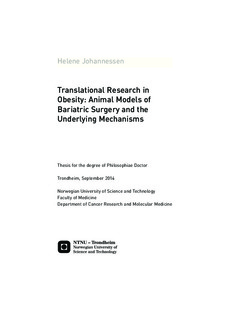| dc.description.abstract | Background/Aims: The number of obese individuals is increasing rapidly, leading to a global obesity epidemic. Only bariatric surgery has demonstrated long-term therapeutic effects, and the use of these procedures is extensive. Considering the large number of obese patients, the risk of surgical complications and high surgery-related cost, development of new, minimally invasive procedures to treat obesity is urgently needed. The principal objective of this thesis was to better understand the physiological mechanisms of bariatric surgery in order to develop minimally or non-invasive obesity treatments using experimental animal models. To this end, specific objectives were i) to evaluate the vagus nerve and the muscarinic acetylcholine M3 receptor as possible therapeutic targets, ii) to investigate the potential of ileal interposition alone and combined with sleeve gastrectomy as bariatric and metabolic surgery, and iii) to investigate the underlying mechanisms of gastric bypass and duodenal switch.
Materials and Methods: A total of 229 animals (rats and mice) were used. Seven different surgical procedures or genetic manipulation have been tested, i.e., vagus nerve stimulation/blocking (VNSB), gastric botulinum toxin type A (Botox) injection, gene knockout of the muscarinic acetylcholine M3 receptor (M3KO), ileal interposition, ileal interposition with sleeve gastrectomy, gastric bypass, and duodenal switch. Physiological variables measured included body weight development, body composition, food intake, eating behavior, metabolic parameters, gastric acid secretion, energy-balance regulating genes in the brain, gut hormones, gastric emptying, fecal energy content, pancreatic and ileal glucagon-like peptide-1 (GLP-1), pancreatic insulin, and cytokines. Dual energy X-ray absorptiometry, open circuit indirect calorimeter, gastric fistula model, taqman array, in situ hybridization, RNA sequencing, radioimmunoassay, acetaminophen absorption assay, adiabatic bomb calorimeter, western blot, immunohistochemistry, and multiplex cytokine assay were used.
Results: VNSB reduced body weight by 10% in normal chow-fed rats, which was associated with reduced food intake, increased expression of anorexigenic neuropeptides in brainstem and hippocampus, and increased expression of hypothalamic orexigenic neuropeptides. Botox injection reduced body weight by 20-30% in normal chow-fed rats, diet induced obese (DIO) rats and DIO rats that had underwent sleeve gastrectomy. The body weight loss was associated with reduced food intake, increased energy expenditure, and increased expression of hypothalamic orexigenic neuropeptides. M3KO mice had a lean phenotype and displayed increased energy expenditure, increased expression of hypothalamic orexigenic neuropeptides but unchanged total food intake. Ileal interposition and sleeve gastrectomy did not reduce body weight, but increased GLP-1 expression in the ileum and pancreatic islets, respectively. Gastric bypass increased energy expenditure and reduced body weight by 15%, while duodenal switch reduced food intake, altered eating behavior, increased energy expenditure, and caused malabsorption, leading to a 54% body weight loss.
Conclusions: The brain-gut axis plays an important role in the regulation of body weight, which makes it an ideal target for obesity treatments. Blocking the gastric vagus nerve, by VNSB or Botox injection, can be used as non- or minimally invasive obesity treatment, and muscarinic acetylcholine M3 receptor antagonists might have potential as obesity treatment. Combining ileal interposition and sleeve gastrectomy would be beneficial to maximize GLP-1 secretion, and holds potential as a metabolic surgery. Duodenal switch induces greater body weight loss than gastric bypass through different mechanisms. | nb_NO |
